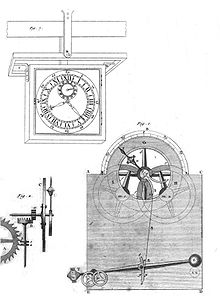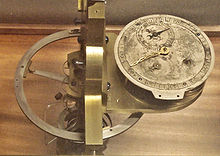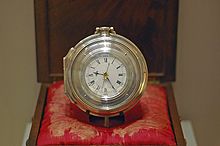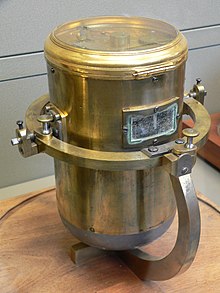Marine chronometer
| Marine chronometer | |
|---|---|
 Bréguet twin barrel box chronometer. | |
| Classification | Clock |
| Industry | Transportation |
| Application | Timekeeping |
| Powered | No |
| Inventor | Christiaan Huygens |
| Invented | 1675 |
A marine chronometer is a clock which is precise enough to be used as a portable time standard; it can therefore be used to determine longitude by means of celestial navigation. When first developed in the eighteenth century it was a major technical achievement, as accurate knowledge of the time over a long sea voyage is necessary for navigation, lacking electronic or communications aids. The first true chronometer was the life work of one man, John Harrison, spanning 31 years of persistent trial and error that revolutionized naval (and later aerial) navigation as the Age of Discovery and Colonialism hit a new gear.
The term chronometer (apparently coined in 1714 by Jeremy Thacker, an early competitor for the prize set by the Longitude Act in the same year)[1] is used more recently to describe wristwatches tested and certified to meet certain precision standards. Timepieces made in Switzerland may only display the word 'Chronometer' if certified by the COSC.
History

To determine a position on the earth's surface, it is necessary and sufficient to know the latitude, longitude and altitude. Altitude considerations can of course be ignored for vessels operating at sea level. Until the mid 1750s accurate navigation at sea out of sight of land was an unsolved problem due to the difficulty in calculating longitude. Navigators could determine their latitude by measuring the sun's angle at noon (i.e., when it reached its highest point in the sky, or culmination). To find their longitude, however, they needed a time standard that would work aboard a ship. Observation of regular celestial motions, such as Galileo's method based on observing Jupiter's natural satellites, was usually not possible at sea due to the ship's motion. The Lunar Distance Method, initially proposed by Johannes Werner in 1514, was developed in parallel with the marine chronometer. The Dutch scientist Gemma Frisius was the first to propose the use of a chronometer to determine longitude in 1530.
The purpose of a chronometer is to measure accurately the time of a known fixed location, for example Greenwich Mean Time (GMT). This is particularly important for navigation. Knowing GMT at local noon allows a navigator to use the time difference between the ship's position and the Greenwich Meridian to determine the ship's longitude. As the Earth rotates at a regular rate, the time difference between the chronometer and the ship's local time can be used to calculate the longitude of the ship relative to the Greenwich Meridian (defined as 0°) using spherical trigonometry. In modern practice, a navigational almanac and trigonometric sight-reduction tables permit navigators to measure the Sun, Moon, visible planets, or any of 57 navigational stars at any time that the horizon is visible.
The creation of a timepiece which would work reliably at sea was difficult. Until the 20th century the best timekeepers were pendulum clocks, but the rolling of a ship at sea made a simple gravity-based pendulum useless.
First marine chronometers
Christiaan Huygens, following his invention of the pendulum clock in 1656, made the first attempt at a marine chronometer in 1673 in France, under the sponsorship of Colbert.[2][3] In 1675, Huygens, who was receiving a pension from Louis XIV, invented a chronometer that employed a balance wheel and a spiral spring for regulation, instead of a pendulum, opening the way to marine chronometers and modern wristwatches. He obtained a patent for his invention from Colbert, but his clock remained imprecise at sea.[4]

More attempts were made by Jeremy Thacker in England in 1714, and Henry Sully in France in 1716, who published his work in 1726 with Une Horloge inventée et executée par M. Sulli, but these inventions remained unable to resist the rolling of the high seas and keep time precisely enough.[5]


John Harrison, a Yorkshire carpenter, then submitted a project in 1730, and completed in 1735 a clock based on a pair of counter-oscillating weighted beams connected by springs whose motion was not influenced by gravity or the motion of a ship. His first two sea timepieces H1 and H2 (completed in 1741) used this system, but he realised that they had a fundamental sensitivity to centrifugal force, which meant that they could never be accurate enough at sea. Construction of his third machine in 1759, designated H3, included novel circular balances and the invention of the bi-metallic strip and caged roller bearings, inventions which are still widely used. H3's circular balances proved too inaccurate and he eventually abandoned the large machines.
Harrison solved the precision problems with his much smaller H4 chronometer design in 1761. H4 looked much like a large five-inch (12 cm) diameter pocket watch. In 1761 Harrison submitted H4 for the £20,000 longitude prize that had been offered by the British government in 1714. His design used a fast-beating balance controlled by a temperature-compensated spiral spring. This general layout remained in use until stable electronic oscillators allowed very accurate portable timepieces to be made at affordable cost. Harrison then published his work with Principles of Mr. Harrison's time-keeper in 1767.[7]
The modern chronometer


About the same time in France, Pierre Le Roy invented in 1748 the detent escapement characteristic of modern chronometers.[8] In 1766, Pierre Le Roy created a revolutionary chronometer that incorporated a detent escapement, the temperature-compensated balance and the isochronous balance spring:[9] Harrison showed the possibility of having a reliable chronometer at sea, but these developments by Le Roy are considered as the foundation of the modern chronometer.[9] The innovations of Le Roy made the chronometer a much more accurate piece than had been anticipated.[10]
Ferdinand Berthoud in France, as well as Thomas Mudge in Britain also successfully produced marine timekeepers.[11] Although none was simple, they proved that Harrison's design was not the only answer to the problem. The greatest strides toward practicality came at the hands of Thomas Earnshaw and John Arnold, who in 1780 developed and patented simplified, detached, "spring detent" escapements[12][13], moved the temperature compensation to the balance, and improved the design and manufacturing of balance springs. This combination of innovations served as the basis of marine chronometers until the electronic era.

The new technology was initially so expensive that not all ships carried chronometers, as illustrated by the fateful last journey of the East Indiaman Arniston.[14] However by 1825, the Royal Navy had begun routinely supplying its vessels with chronometers.[15]
It was common for ships at the time to observe a time ball, such as the one at Greenwich, to check their chronometers before departing on a long voyage. Every day, ships would anchor briefly in the River Thames at Greenwich, waiting for the ball at the observatory to drop at precisely 1pm.[16] This practice was responsible for the subsequent adoption of Greenwich Mean Time as an international standard.[17] (Time balls became redundant around 1920 with the introduction of radio time signals, which have themselves largely been superseded by GPS time.) In addition to setting their time before departing on a voyage, ship chronometers were also routinely checked for accuracy while at sea by carrying out lunar[18] or solar observations.[19]
Although industrial production methods began revolutionizing watchmaking in the middle of the 19th century, chronometer manufacture remained craft-based much longer. Around the turn of the 20th century, Swiss makers such as Ulysse Nardin made great strides toward incorporating modern production methods and using fully interchangeable parts, but it was only with the onset of World War II that the Hamilton Watch Company in the US perfected the process of mass production, which enabled them to produce thousands of their superb Hamilton Model 21 chronometers for the US and other Allied navies. Despite Hamilton's success, chronometers made in the old way never disappeared from the marketplace during the era of mechanical timekeepers. Mercer of St. Albans in Britain, for instance, continued to produce high-quality chronometers by traditional production methods well into the 1970s.
Without their accuracy and the accuracy of the feats of navigation that marine chronometers enabled, it is quite likely the ascendancy of the Royal Navy, and by extension that of the British Empire, would not have occurred; the formation of the empire by wars and conquests of colonies abroad took place in a period in which British vessels had reliable navigation due to the chronometer, while their Portuguese, Dutch, and French opponents did not.[20] For example: the French were well established in India and other places before Britain colonized or trade, but were defeated by naval forces in the Seven Years' War.
The most complete international collection of marine chronometers, including Harrison's H1 to H4, is at the National Maritime Museum, Greenwich, Britain.
Mechanical chronometers

The crucial problem was to find a resonator that remained unaffected by the changing conditions met by a ship at sea. The balance wheel harnessed to a spring solved most of the problems associated with the ship's motion. Unfortunately, the elasticity of most balance spring materials changes relative to temperature. To compensate for ever-changing spring strength, the majority of chronometer balances used bi-metallic strips to move small weights toward and away from the center of oscillation, thus altering the period of the balance to match the changing force of the spring. The balance spring problem was solved with a nickel-steel alloy named Elinvar for its invariable elasticity at normal temperatures. The inventor was Charles Edouard Guillaume, who won the 1920 Nobel Prize for physics in recognition for his metallurgical work (the only Nobel that has been granted for work related to horology).
The escapement serves two purposes. First, it allows the train to advance fractionally and record the balance's oscillations. At the same time, it supplies minute amounts of energy to counter tiny losses from friction, thus maintaining the equilibrium of the oscillating balance. The escapement is the part that ticks. Since the natural resonance of an oscillating balance serves as the heart of a chronometer, chronometer escapements are designed to interfere with the balance as little as possible. There are many constant force and detached escapement designs, but the most common are the spring detent and pivoted detent. In both of these, a small detent locks the escape wheel and allows the balance to swing completely free of interference except for a brief moment at the center of oscillation, when it is least susceptible to outside influences. At the center of oscillation, a roller on the balance staff momentarily displaces the detent, allowing one tooth of the escape wheel to pass. The escape wheel tooth then imparts its energy on a second roller on the balance staff. Since the escape wheel turns in only one direction, the balance receives impulse in only one direction. On the return oscillation, a passing spring on the tip of the detent allows the unlocking roller on the staff to move by without displacing the detent.
Chronometers often included other innovations to increase their efficiency and precision. Hard stones such as ruby and sapphire were often used as jewel bearings to decrease friction and wear of the pivots and escapement. Until the end of mechanical chronometer production in the third quarter of the 20th century, makers continued to experiment with things like ball bearings and chrome-plated pivots.
Marine chronometers always contain a maintaining power which keeps the chronometer going while it is being wound, and a power reserve to indicate how long the chronometer will continue to run without being wound. Marine chronometers are the most accurate portable mechanical clocks ever made, achieving a precision of around a tenth of a second per day. This is accurate enough to locate a ship's position within 4,600 feet (1,400 m) after a month's sea voyage.
Today
Ships and boats commonly utilize electronic aids to navigation, such as LORAN and Global Navigation Satellite Systems. However celestial navigation, which requires the use of a precise chronometer, is still a requirement for certain international mariner certifications such as Officer in Charge of Navigational Watch, and Master and Chief Mate deck officers,[21][22] and supplements offshore yachtmasters on long-distance private cruising yachts.[23][24] Modern marine chronometers can be based on quartz clocks that are corrected periodically by GPS signals or radio time signals (see radio clock). These quartz chronometers are not always the most accurate quartz clocks when no signal is received, and their signals can be lost or blocked. However, there are quartz movements, even in wrist watches, that are accurate to within 10 or 20 seconds per year.[25] At least one quartz chronometer made for advanced navigation utilizes multiple quartz crystals which are corrected by a computer using an average value, in addition to GPS time signal corrections.[26][27]
See also
- Clockmaker
- Larcum Kendall
- Noon Gun
- Timeball
- Time signal
- Railroad chronometer
- Rupert Gould, author of the definitive history of the marine chronometer
- Radio-controlled watch
- Watchmaker
- Timeline of invention
References
- ^ Sobel, Dava. Longitude: The True Story of a Lone Genius Who Solved the Greatest Scientific Problem of His Time. Penguin Books. pp. 56, 57. ISBN 0-14-025879-5 Dismissing other solutions to the longitude problem, Thacker wrote "In a word, I am satisfied that my Reader begins to think that the ''Phonometers, Pyrometers, Selenometers, Heliometers'' and all the ''Meters'' are not worthy to be compared to my ''Chronometer''".
{{cite book}}: Check|isbn=value: invalid character (help) - ^ Discovering the Great South Land Byron Heath p.167 [1]
- ^ The maze of ingenuity: ideas and idealism in the development of technology Arnold Pacey New p.133ff [2]
- ^ Time for science education by Michael R. Matthews p.152 [3]
- ^ A Chronology of Clocks
- ^ The principles of Mr Harrison's time-keeper
- ^ Principles of Mr. Harrison's time-keeper
- ^ Britten's Watch & Clock Makers' Handbook Dictionary & Guide Fifteenth Edition p.122 [4]
- ^ a b Encyclopedia of time Samuel L. Macey p.348 [5]
- ^ A history of mechanical inventions Abbott Payson Usher p.330 [6]
- ^ Britten's Watch & Clock Makers' Handbook Dictionary & Guide Fifteenth Edition p.122 [7]
- ^ Landes, David S. (1983). Revolution in Time. Cambridge, MA: Belknap Press of Harvard University Press. p. 165. ISBN 0-674-76800-0.
{{cite book}}: Cite has empty unknown parameter:|coauthors=(help) Pierre Le Roy had developed the detached spring detent escapement around 1748 but abandoned the concept. - ^ Encyclopedia of time Samuel L. Macey p.349 [8]
- ^ HALL, Basil (1833 1862). "Chapter XIV. Doubling the cape.". The Lieutenant and Commander. London: Bell and Daldy (via Gutenberg.org). OCLC 9305276. Retrieved 2007-11-09.
{{cite book}}: Check date values in:|year=(help)CS1 maint: multiple names: authors list (link) CS1 maint: year (link) - ^
Britten, Frederick James (1894). Former Clock & Watchmakers and Their Work. New York: Spon & Chamberlain. pp. p230. Retrieved 2007-08-08.
Chronometers were not regularly supplied to the Royal Navy till about 1825
{{cite book}}:|pages=has extra text (help) - ^ Golding Bird (1867). The Elements of Natural Philosophy; Or, An Introduction to the Study of the Physical Sciences. J. Churchill and Sons. pp. p545. Retrieved 2008-09-24.
{{cite book}}:|pages=has extra text (help) - ^ Tony Jones. Splitting the Second. CRC Press. pp. p121. ISBN 0750306408+date=2000.
{{cite book}}:|pages=has extra text (help); Check|isbn=value: invalid character (help) - ^ Nathaniel Bowditch, Jonathan Ingersoll Bowditch (1826). The New American Practical Navigator. E. M. Blunt. pp. p179.
{{cite book}}:|pages=has extra text (help) - ^ Norie, J. W. (1816). "To Find The Logitude of Chronometers or Time-Keepers". New and Complete Epitome of Practical Navigation.
- ^ Alfred T. Mahan, The Influence of Sea Power on History:
- ^ "International Convention on Standards of Training, Certification and Watchkeeping for Seafarers, 1978". Admiralty and Maritime Law Guide, International Conventions. Retrieved 2007-09-22.
- ^ "International Convention on Standards of Training, Certification and Watchkeeping for Seafarers (with amendments)". International Maritime Organization. Retrieved 2007-09-22.
- ^ "International Yachtmasters at Maritime Institute, Yachtmasters Course". The Maritime Institute. Retrieved 2007-09-22.
- ^ "Royal Yachting Association Yachtmaster Training". The Royal Yachting Association. Retrieved 2007-09-22.
- ^ Read, Alexander. "High accuracy timepieces that could be used as marine chronometer". Retrieved 2007-09-22.
- ^ Montgomery, Bruce G. "Keeping Precision Time When GPS Signals Stop". Cotts Journal Online. Retrieved 2007-09-22.
- ^ "Precise Time and Frequency for Navy Applications: The PICO Advanced Clock". DoD TechMatch, West Virginia High Technology Consortium Foundation. Retrieved 2007-09-22.
External links
- National Maritime Museum, Greenwich
- Henri MOTEL n°258 Chronomètre de Marine 40 heures
- GUB Marine-Chronometer caliber 100 - Presentation of marine chronometers of "Glashütter Uhrenbetriebe VEB" with picture and explanation (German)
Link to H1 animation for iPad
link to H1 animation for iPhone


